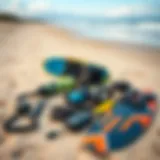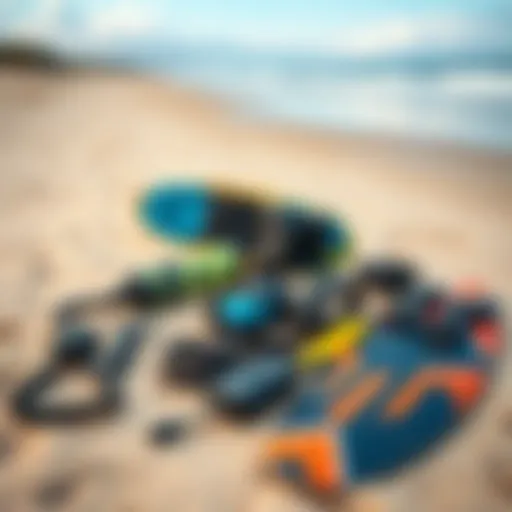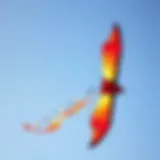Kitesurfing in Honolulu: A Complete Guide for Enthusiasts
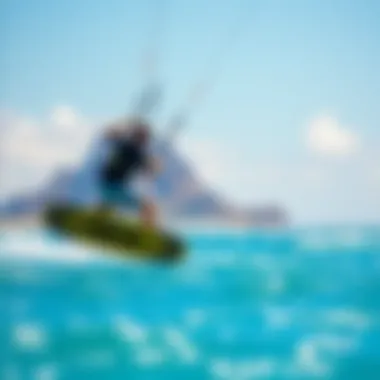
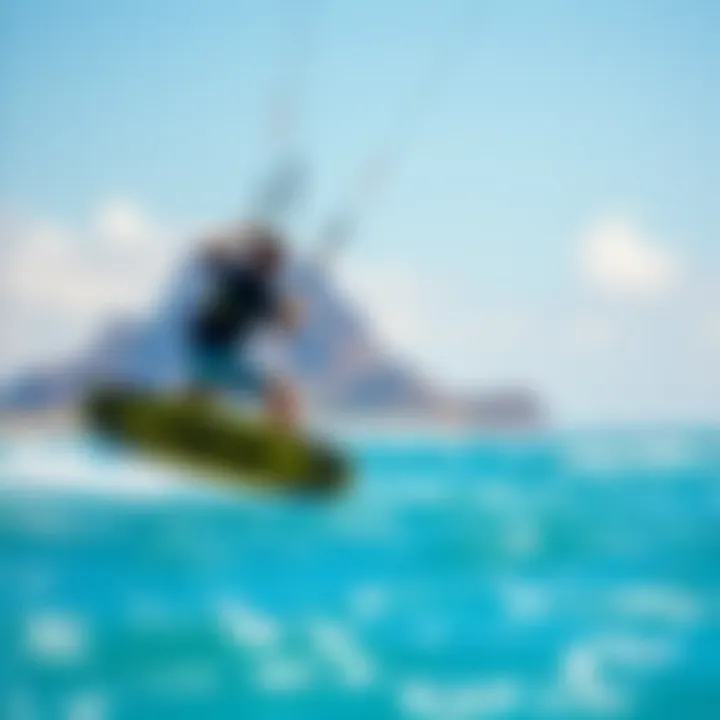
Intro
Kitesurfing in Honolulu offers an exhilarating experience, merging the thrill of surfing with the freedom of flying. Situated in the heart of Hawaii, Honolulu is blessed with stunning coastlines and consistent winds, making it a premier destination for both newcomers and seasoned kiteboarders. The surf culture here is not merely about riding the waves; it embodies a rich tapestry of local traditions, community spirit, and a deep connection to the ocean.
Before you dive into the turquoise waters, it’s important to understand the fundamental aspects that shape the kitesurfing scene in this idyllic location. The following insights will guide you through essential gear choices, advanced techniques, safety protocols, and a glimpse into the vibrant community that surrounds this sport.
With a wealth of information at your fingertips, you’re well on your way to carving your path in the realm of kitesurfing, and to feeling that exhilarating rush of wind as you slide across the water.
Intro to Kitesurfing in Honolulu
Kitesurfing is not just a sport; in Honolulu, it’s an experience that intertwines the thrill of wind and water with the tropical beauty of the Hawaiian landscape. This guide delves into the ins and outs of kitesurfing in Honolulu, showcasing why this location is special for both beginners and seasoned pros alike.
Many enthusiasts flock to Hawaii not just for sun and surf, but for the opportunity to indulge in activities that marry adrenaline with nature. Kitesurfing stands out in this regard, offering the chance to harness the winds that sweep across Oahu's pristine beaches. The allure lies not only in the sport itself but also in how it connects individuals to the stunning surroundings. Kitesurfing in Honolulu provides a unique way to explore the coastlines, adding a breathtaking perspective to the rich tapestry of island life.
The Benefits of Kitesurfing in Honolulu
The favorable wind patterns and scenic vistas serve as a massive draw for kitesurfing enthusiasts. The warm waters of the Pacific Ocean provide an ideal environment for the sport, allowing for longer sessions without the chill that can occur in other regions.
In addition, the community surrounding kitesurfing in Honolulu is vibrant and welcoming. Local shops, schools, and experienced instructors are readily available, fostering a culture of learning and sharing among kiteboarders. This makes it easier for newcomers to meet people who share their interests and for veterans to find like-minded adventurers.
Remember, kitesurfing is not just about tearing through the waves. It's about enjoying the thrill, sharing laughs with fellow riders, and discovering the beauty of Hawaii from a new angle.
Considerations to Keep in Mind
However, kitesurfing is not without its complexities. Weather patterns can change rapidly, and novices must take care to understand local conditions before hitting the water. Ensuring safety through proper training and understanding the environment can make all the difference in having an enjoyable experience.
Moreover, as much as this sport fosters camaraderie, it also requires a sense of respect for the ocean and those who share it. Following local guidelines and understanding the cultural significance of the activity enhances not only the kitesurfing experience but enriches one’s connection to the Hawaiian lifestyle.
In summary, introducing kitesurfing in Honolulu is about recognizing a sport that embodies the spirit of adventure and community. As we navigate through the geographical considerations, top spots, and essential safety measures, it becomes clear that kitesurfing in this stunning locale opens up a world of possibilities, steeped in both exhilaration and respect for nature.
Geographical Considerations
When delving into the world of kitesurfing, understanding the geographical aspects of Honolulu serves as a pivotal foundation for both novice and seasoned enthusiasts. The unique topography and climate of Oahu, particularly around Honolulu, shape the conditions that make kitesurfing an exciting and sometimes challenging endeavor. Getting acquainted with these geographical elements is not just a matter of convenience; it can really make or break your ride on the waves.
The Wind Patterns of Oahu
Oahu’s wind patterns aren’t just a trifle to glance at; they play a crucial role in the kitesurfing landscape. Predominantly, the trade winds sweep across the island, generally from the northeast, creating ripples that thrill kiteboarders. These winds are typically most consistent during the summer months, usually from May to September. Average wind speeds can range from a mild 10 knots on calmer days to a brisk 25 knots when conditions are at their peak, making it a paradise for those who crave a thrill.
However, wind conditions can be tricky. On some days, localized weather phenomena can shift these patterns, leading to sudden gusts that may catch the unprepared off guard. Given this, it’s wise to pay careful attention to local weather forecasts and seek insights from fellow kitesurfers. Furthermore, the two most notable wind directions—called the Kona winds and the trade winds—provide contrasting experiences; where the former can smooth out the sea while creating waves on the southern shores.
"Understanding the winds is as crucial as mastering the board itself." - A local kitesurfing instructor
Understanding the Ocean Currents
Equally imperative to grasp are the ocean currents, which govern the flow of water around Oahu and significantly influence kitesurfing conditions. While kitesurfers often focus on the wind, ocean currents also hold substantial sway over ride quality, safety, and overall enjoyment.
On the southeast coast, swift currents can be challenging, and due to the layout of the land, they can lead to sudden changes in water depth. Being informed about these dynamics can mean the difference between a pleasant outing and a harrowing experience. In contrast, the calmer waters along Kailua Beach provide a safer setting for beginners, allowing them to hone their skills amidst gentle currents.
- Key Currents to Watch:
- Kailua Current: Gentle and beginner-friendly, ideal for learning.
- North Shore Rip Currents: More challenging, suitable for advanced riders looking for excitement.
The interplay of wind and currents ensures that kitesurfing in Honolulu isn’t a one-size-fits-all activity. Whether a kiteboarder prefers thrashing through the waves or gliding smoothly, being mindful of the geographical elements truly elevates the experience. Understanding these factors helps in crafting a session that aligns with one’s skill level and adventurous spirit.
Top Kitesurfing Spots in Honolulu
Kitesurfing in Honolulu offers carpeted vistas of blue waves and palm-fringed beaches, making it a paradise for enthusiasts of all levels. The unique geophysical characteristics of each beach, combined with their accessibility and amenities, mean that there is a perfect spot for every type of kiteboarder. In this section, we will highlight three prime locations: Kailua Beach, Lanikai Beach, and the North Shore. Each spot comes with its own specific advantages, allowing a kitesurfer to experience the splendor of Hawaii in different ways.
Kailua Beach
Kailua Beach is often described as kitesurfing's crown jewel, and for good reason. The beach boasts consistent trade winds, which create reliable conditions almost year-round. With a focus on safety, the bay offers ample room to launch and land kites away from the crowds, making it ideal for both novices and seasoned riders alike. The soft white sand and clear waters also add to the allure, giving practitioners a striking backdrop as they glide across the surface.
Key Features of Kailua Beach:
- Shallow Waters: Perfect for beginners to practice and build confidence in their skills.
- Wind Consistency: The trade winds here typically range from 15 to 25 knots, excellent for a spirited session.
- Crowd Control: The beach is vast, allowing multiple kitesurfers to spread out without interfering with each other.
A unique benefit to this spot is that it’s just a stone’s throw away from local shops which offer rental gear. It’s not unusual to see friendly locals giving tips to newcomers, fostering a close-knit kitesurfing community.
Lanikai Beach
While Kailua tends to attract a fair number of kiteboarders, Lanikai Beach has a reputation for its slightly more challenging conditions. It is often less crowded, allowing for an uninterrupted session. The views of the Mokulua Islands from the beach provide a picturesque setting, making it not only a place to kitesurf but also a magnet for photographers.
Highlights of Lanikai Beach:
- Scenic Beauty: Lanikai is often cited as one of the most beautiful beaches in the world.
- Ideal for Intermediate Riders: Its more challenging currents and winds suit surfers looking to push their boundaries.
- Quiet Atmosphere: If you enjoy kitesurfing without the usual hustle and bustle, this spot can be your sanctuary.
Before heading out, it's best to gain insight into the timing of the tides and wind conditions. Some surfers recommend early morning sessions when the wind is more favorable and the crowds are thin.
The North Shore
Often celebrated for its formidable surf, the North Shore is not only a realm for waves but also a haven for advanced kitesurfers. This region can offer extremely powerful winds and some sizable waves during the Hawaiian winter months. If you’re looking to elevate your kitesurfing skills, this is the location that can help you break through your limits.
Key Aspects of the North Shore:
- Challenging Conditions: Perfect for those who want to test their skills against both wind and waves.
- Variety of Spots: Various beaches along the North Shore cater to different wind and wave conditions.
- Community Vibes: The North Shore is a melting pot of surfers and kitesurfers, creating a vibrant culture around the sport.
Before heading out to the North Shore, keep in mind that it can be perilous for inexperienced kitesurfers due to the unpredictable conditions. It might be wise to team up with a local who knows the waters well.
Best Conditions for Kitesurfing
Kitesurfing thrives on the synergy of wind and water, with optimal conditions significantly enhancing the experience. It's more than just a leisurely ride; understanding the best conditions can mean the difference between an exhilarating day on the waves and a less than pleasing outing. The interplay of seasonal variations and weather patterns creates a dynamic landscape for kitesurfers in Honolulu. As such, knowing when to hit the water and what to expect allows enthusiasts to plan their adventures with confidence.


Seasonal Variations
Hawaii is known for its pleasant weather year-round, but the seasons bring unique characteristics to kitesurfing conditions. Generally, the best months for kitesurfing in Honolulu are during Hawaii's summer and fall—specifically, from May to September. During this period, the trade winds blow consistently, averaging between 15 to 25 knots. This is ideal for both beginners and seasoned riders.
However, the local climate shifts in the winter months, with stronger winds but also more unpredictable conditions. The winter months from November to March may bring a different set of challenges.
- Summer (May - September): Steady winds and warmer water temperatures attract many kitesurfers.
- Fall (October): A mix of summer's warmth and the onset of winter winds.
- Winter (November - March): Potential for stronger winds but also rougher sea conditions, necessitating caution.
- Spring (April): Transition period where conditions can vary significantly, often with less wind than summer.
Being aware of these seasonal changes allows kitesurfers to adapt their gear and techniques to align with current conditions. It is wise to keep an eye on forecasts and consult knowledgeable locals or instructors who can provide insights on the best times to surf.
Weather Patterns and Safety
Weather plays an essential role in kitesurfing, especially in terms of safety. Understanding how weather patterns affect conditions not only enhances performance but also helps to avoid dangerous situations. Key weather elements to monitor include:
- Wind Speed and Direction: Reliable sources for real-time weather updates, such as https://www.wunderground.com or local meteorological services, can offer insights into wind speed and direction. Ideal wind directions at Honolulu's popular spots vary, so knowing where to kite depending on conditions is crucial.
- Storms and Lightning: Always keep an eye on the horizon. Sudden storms can crop up, and kitesurfers should exit the water if they see dark clouds forming or hear thunder. Kites don't mix well with lightning—this ain’t a risk worth taking.
- Water Conditions: Wave heights and safety are paramount. Flat water is generally better for beginners, while those more experienced may prefer larger swells. Knowing one's skill level in relation to the water conditions will pay dividends in safety and enjoyment.
"Weather can be unpredictable, but preparation is key. Stay updated, and always trust your instincts about heading to shore."
When planning a kitesurfing trip, consider combining the seasonal insights with regular checks of the weather patterns. Local kitesurfing communities, forums, and social media platforms can also be valuable resources for getting timely updates. Websites like www.reddit.com/r/kitesurfing can facilitate communication with locals who may share recent experiences or tips on conditions.
Essential Gear for Kitesurfing
Kitesurfing is not just about the thrill of riding the waves; it heavily hinges on the gear you use. Having the right equipment can make a substantial difference in your performance, safety, and overall enjoyment. With the diverse conditions found in Honolulu, ensuring you have suitable gear isn’t merely recommended—it’s essential. Each piece of equipment plays a pivotal role, from your kite selection to safety precautions, ensuring that you are well-equipped for the unique challenges that Oahu’s beaches present.
Choosing the Right Kite
Selecting the right kite is akin to finding the perfect partner; they should complement your style and skill level. Kites come in various shapes and sizes, each suited for different wind conditions and rider preferences. For instance, if you’re a beginner, you might want a larger kite that provides ample lift and stability. Conversely, experienced riders often opt for a smaller kite that allows for higher speeds and aerial tricks.
A few key considerations when selecting your kite include:
- Wind Range: Ensure that the kite suits the average wind conditions you expect to encounter.
- Style of Riding: Freestyle, wave riding, or racing—knowing your preference helps narrow down the options.
- Material and Design: The build quality affects durability and performance.
Take note that local shops on the island, such as Hawaiian Watersports, can provide valuable insights and recommendations.
Boards: Types and Recommendations
Picking the right board is just as critical as your kite. The board affects maneuverability and speed. There are various types, each catering to specific riding styles. Here’s a quick look at some popular choices:
- Twin-Tip Boards: Great for all-around use, these are symmetrical and easy to ride in both directions, making them ideal for beginners and freestyle enthusiasts alike.
- Directional Boards: These are typically used for wave riding and provide better performance in surf conditions. They’re designed to be ridden in one direction, unlike twin-tips.
- Foil Boards: For those looking to ride above the water, foil boards utilize a hydrofoil that lifts the board out, allowing for smooth rides even in choppy conditions.
Ultimately, choose a board that not only suits your skill level but also aligns with the conditions you'll be facing at spots like Kailua or Lanikai.
Safety Equipment and Accessories
Even if you're an ace on the water, overlooking safety gear is a major no-no. This gear is crucial to safeguarding your life and enabling you to enjoy kitesurfing fully. Here’s a starter kit of equipment you should consider:
- Impact Vest: These provide protection from falls and impact, useful when taking a hard tumble on the water.
- Harness: A well-fitted harness distributes the pull of the kite evenly across your body, minimizing fatigue.
- Life Jacket: An appropriately rated personal flotation device boosts your safety, especially in unfamiliar waters.
- Leashes: A safety leash can prevent runaway kites, helping keep equipment under control.
"Kiting without safety gear is like swimming without a life jacket—a risk you can avoid."
Arranging your gear meticulously can mean the difference between a fantastic session and an unfortunate mishap. So, it’s best to invest in quality equipment and accessories that serve you well.
Remember, local kitesurfing schools often offer rentals for equipment if you're just starting or want to test different types of gear before purchasing. You can find some recommendations on community forums like Reddit’s Kitesurfing Sub.
Safety Protocols in Kitesurfing
Understanding and implementing safety protocols in kitesurfing is essential for anyone looking to engage in this exhilarating sport. While the thrill of soaring over waves and harnessing the power of the wind is unbeatable, it’s equally crucial to recognize the potential hazards that come with it. Safety measures not only protect individuals but also ensure that the kitesurfing community thrives by minimizing accidents and fostering a respectful environment on the water.
Understanding Risks and Hazards
Every sport comes with its risks, and kitesurfing is no different. Riders need to be aware of the following hazards:
- Wind Variation: Winds can be unpredictable; stronger gusts can catch even seasoned kitesurfers off guard. Understanding local wind patterns, especially in regions like Honolulu, is key to choosing the right time to go out.
- Ocean Conditions: Currents, waves, and water temperatures can change quickly. This can lead to disorientation or even exhaustion if a kitesurfer finds themselves caught in challenging conditions.
- Collision Risks: Whether it’s with other kitesurfers, swimmers, or objects in the water, being mindful and maintaining a safe distance is necessary to prevent collisions.
A good practice is always to check the surf report and forecasts before heading out. Get familiar with the environment; local knowledge is invaluable. Remember to assess your skill level honestly—if conditions look imposing, it’s best to sit it out.
Importance of Local Regulations
Honolulu, like many other popular kitesurfing destinations, has specific regulations aimed at ensuring safety and preserving the local ecosystem. Adhering to these regulations not only enhances safety but also demonstrates respect for the local community and nature.
- Designated Kiting Areas: Many beaches have specific zones where kitesurfing is permitted to keep the activities safe and organized. These areas are often chosen for their ideal wind and water conditions.
- Local Guidelines: Each beach may have its own rules—whether regarding times of use, required equipment, or interaction with marine life (for instance, avoiding turtles or other protected species).
- Permits and Permissions: Some areas might require permits for kitesurfing which helps regulate the number of enthusiasts on the water. This is especially important during peak seasons to maintain a safe environment for all.
"Following local regulations ensures not just your safety, but that of others sharing the water—it's a win-win for everyone."
While the allure of kitesurfing is captivating, it’s fundamental to appreciate the gravity of its risks and the need for regulations. When everyone plays by the rules, the kitesurfing experience becomes safer and more enjoyable for all. So pack your gear and know this: with great power comes great responsibility!
Cultural Significance of Kitesurfing in Hawaii
Kitesurfing in Hawaii is not merely a sport; it embodies a connection to the islands’ rich culture and history. As the popularity of kitesurfing has surged, it has woven itself into the fabric of daily life in communities such as Honolulu, where the wind, waves, and sun coalesce to create an enticing playground. Understanding the cultural significance of kitesurfing reveals how the sport has become a vital element of both local identity and tourism.
The Evolution of Watersports in Hawaii
Oahu’s waters have long attracted adventurers seeking the thrill of the ocean. The evolution of watersports here can be traced back to traditional Hawaiian practices, which celebrated the ocean as a source of sustenance and connection. Surfing, known as he'e nalu, was historically revered and played an integral role in community bonding and cultural practices.
When kitesurfing emerged on the scene, it brought with it a fresh wave of excitement. Much like surfing, it captured the imaginations of the local youth and tourists alike. The combination of speed and agility in kitesurfing appealed to those who sought innovation in their ocean pursuits. Over the years, local kitesurfers have adapted this sport, developing techniques and styles that reflect the Hawaiian spirit, further enhancing its cultural legacy in places like Kailua and Lanikai, which are bustling kitesurfing hubs.
"Kitesurfing unites us with the wind and waves, offering a unique freedom that echoes in our traditions."
Connecting with Local Communities
The kitesurfing community in Honolulu acts as a bridge, connecting enthusiasts from varied backgrounds. This sport fosters friendships and collaborations that transcend age and ethnicity. Local schools and instructors often engage in outreach programs, encouraging younger generations to pick up the sport. These initiatives keep the local culture alive, passing down the passion for ocean sports while bolstering community ties.


Local kitesurfing events attract both participants and spectators, creating a vibrant atmosphere filled with shared stories and experiences. Participants often spend time after a session discussing techniques, sharing tips on gear, and even exploring beloved local spots together. The communal aspect of kitesurfing enhances the experience, turning it into a social gathering where bonds are forged and local pride is celebrated.
Kitesurfing Lessons and Instructors
Kitesurfing is more than just strapping a board to your feet and flying a kite. It merges physics, skill, and an understanding of the natural elements. Having a good instructor makes all the difference in learning this exhilarating sport. When it comes to kitesurfing in Honolulu, lessons from certified instructors not only accelerate your learning curve but might also keep you out of trouble on the waves.
The ocean can be unpredictable. Understanding the local wind patterns, waves, and currents is vital for safety and performance. Your choice of instructor will play a crucial role in your development, helping you navigate both the basics and advanced techniques. Beginners benefit immensely from structured courses, while seasoned enthusiasts can refine their skills or explore new tricks with guidance from experienced pros.
In addition to safety and skill enhancement, training with a certified instructor helps you build confidence in your abilities, which is especially crucial when you're out there alone, surrounded by the beauty of the Hawaiian coastline.
Finding Certified Instructors
When seeking out a qualified kitesurfing instructor in Honolulu, you’ll want to make sure they have the right credentials. Look for instructors certified by established organizations, such as the International Kiteboarding Organization (IKO) or the American Kiteboarding Association (AKA). These certifications ensure that instructors have undergone proper training themselves.
Another essential aspect to consider is experience. A seasoned instructor knows the ins and outs of the local spots, wind patterns, and can provide tailored lessons based on your skill level. Recommendations from fellow kitesurfers, online forums, or social media groups can also assist you in making an informed choice. Websites like Kiteforum and local kitesurfing shops often offer directories of instructors and schools.
Don't hesitate to ask prospective instructors about their teaching methodology and safety protocols as well. The right fit should not only be knowledgeable but also able to communicate effectively with students.
Types of Courses Available
Kitesurfing lessons can vary greatly in content and duration, catering to a range of skill levels and needs. Here’s an overview of the common types of courses you can expect:
- Beginner Courses: Generally focus on the fundamental skills, including kite control, safety measures, and basic board riding. These classes often happen on land before transitioning to water lessons.
- Intermediate Lessons: Designed for those who have a handle on the basics. These sessions focus on fine-tuning techniques, tackling more complex maneuvers like jumps and turns, and enhancing board skills.
- Advanced Courses: Targeted at experienced kiteboarders seeking to master specific tricks or adjust their riding style. Often one-on-one sessions that provide tailored feedback for improvement.
- Safety Courses: Given the risks associated with kitesurfing, some instructors offer courses focused on safety practices, including self-rescue techniques and emergency response.
Many schools in Honolulu also provide personalized sessions, which allow for flexibility based on your learning pace. You can arrange courses that highlight aspects you want to learn, from riding waves to performing tricks.
In summary, taking lessons with certified instructors not only equips you with essential skills but also enhances your overall kitesurfing experience. With the right guidance, you're not just learning a sport, you're becoming part of a vibrant community.
Kitesurfing Events and Competitions
Kitesurfing events and competitions play a significant role in shaping the kitesurfing culture in Honolulu. They not only showcase the skills of local and international riders but also foster a sense of community among enthusiasts. Such gatherings offer an opportunity for kiteboarders to exchange tips and techniques while providing a lively atmosphere for spectators. Beyond the thrill of competition, these events elevate the profile of kitesurfing as a sport, attracting new participants and boosting awareness about the environmental aspects tied to ocean sports. When community comes together, the enthusiasm for kitesurfing is palpable, and it underscores the unity of adventure and camaraderie that binds participants.
Annual Events in Honolulu
Honolulu hosts several annual kitesurfing events that attract talent from near and far. One of the most notable is the Hawaii Kitesurfing Championship held at Kailua Beach. This event typically sees athletes compete in various categories from freestyle to racing. Another popular date on the kitesurfing calendar is the Kiteboarding for Cancer charity event. This lively happening combines the spirit of competition with a good cause, where funds raised go towards supporting cancer research.
To participate or attend these events, kiteboarders and fans should keep an eye on the local kitesurfing community's online forums as well as social media platforms.
- Hawaii Kitesurfing Championship
Highlights: Freestyle contests, prizes, and bonding moments with fellow kitesurfers. - Kiteboarding for Cancer
Highlights: Charity focus, fun for all levels, live music and food.
Participation and Spectator Information
For those looking to hit the waves during these events, registration is usually straightforward, with details often published on event-specific websites or local kitesurfing Facebook pages. How to participate:
- Pay the Registration Fee: Costs vary based on the event, so always check the official site.
- Prepare Your Gear: Make sure your kite and board are in good condition.
- Training: If you're a competitor, take some time before the event to practice essential maneuvers.
Spectators are equally important to the atmosphere, bringing their enthusiasm and cheering on competitors. Facilities at the event locations typically include food stalls, equipment rentals, and professional coaching booths for those keen to learn or improve their skills.
"Events are not just about competition; they’re about bringing people together and celebrating the joy of kitesurfing."
Even if participants have no interest in competing, watching the varied styles and techniques of experienced riders can be educational and inspiring. One might even spot some rising stars among the mix. So whether you’re in it for the fun or just there to soak in the experience, Honolulu's kitesurfing events invite everyone to be a part of this spirited ocean culture.
Environmental Considerations in Kitesurfing
Kitesurfing, while exhilarating and fun, also bears a significant responsibility towards the environment. In the vibrantly rich ecosystems of Honolulu, the interplay between this sport and nature is a crucial topic. Understanding the environmental implications can help ensure the sustainability of both the sport and the natural surroundings that attract enthusiasts from around the globe. This section aims to highlight the positive and negative effects kitesurfing has on local ecosystems and how kiteboarders can minimize their impact while enjoying their passion.
Impact of Kitesurfing on Local Ecosystems
Kitesurfing can certainly stir up the waters, but it doesn’t just affect the surface; the interactions between the sport and the local environment run deeper. The turbulent waters caused by kitesurfing can disrupt marine habitats. For instance, the areas around coral reefs are delicate. When kitesurfers glide through these zones, they might unintentionally cause damage to fragile reef systems and disturb the aquatic life that thrives there.
Moreover, the presence of kayaks, boats, and, of course, fellow kitesurfers can lead to erosion on popular beaches such as Kailua and Lanikai. Foot traffic and equipment can compact the sand, leading to loss of vegetation that holds the beach together, subsequently affecting not only the picturesque landscapes but also the animals that rely on those habitats.
It's vital for kitesurfers to be cognizant of their surroundings, respecting designated areas, and refraining from venturing too close to restricted zones or where local wildlife congregates. This awareness can be the thin line between enjoying the thrill of the sport and safeguarding the environment.
"Nature does not hurry, yet everything is accomplished." - Lao Tzu
Sustainable Practices for Enthusiasts
So, how can kiteboarders make a positive impact? It's not doom and gloom; rather, it requires a shift in perspective towards sustainability. Here are some sustainable practices that kitesurfers should consider:
- Support Local Conservation Initiatives: Engaging with local environmental groups focused on ocean conservation can be beneficial. Many organizations run programs like beach clean-ups or educational workshops that inform enthusiasts about preserving marine ecosystems.
- Practice Eco-Friendly Kiting: Stick to the designated kiting zones and steer clear of sensitive areas. When possible, use environmentally friendly and biodegradable gear. Some companies produce kites and boards made from sustainable materials.
- Educate Others: Share knowledge about ecological considerations within the kitesurfing community. It’s not just about enjoying the winds and waves; it’s also about educating peers on the importance of preserving our oceans for future generations.
- Recycle Gear: Old kites and equipment can be a nuisance when not disposed of properly. Look for local recycling programs that accept kitesurfing gear. Some organizations even host swap meets where gear can find a second life.
Through thoughtful actions, the kitesurfing community can enjoy the sport and contribute positively to the preservation of the stunning ecosystems that yield such exhilarating experiences. By embedding sustainability into the culture of kitesurfing, enthusiasts can ensure that they keep flying high without compromising the environment.
Kitesurfing Gear Reviews
Kitesurfing, like any sport that thrives on adventure, is seasonally influenced by one’s choice of gear. The right equipment can enhance both performance and safety while navigating the exhilarating waters of Honolulu. This section focuses on the importance of kitesurfing gear reviews, emphasizing what to look for, the benefits of staying updated with the latest gear trends, and how informed choices can transform your kitesurfing experience.
Latest Kite Models
When evaluating kitesurfing gear, the kite itself deserves a significant spotlight. The latest kite models are often the result of continuous innovation, designed to boost performance across varying wind conditions. New advancements often include lighter materials that enhance lift and control, plus designs tailored specifically for waves versus freestyle maneuvering.
For instance, brands like Cabrinha and F-One have recently rolled out models that offer easy relaunch capabilities, particularly beneficial for beginners learning to navigate Hawaii's breezy waters. Each kite's size, shape, and intended use should be carefully considered; a larger kite might work wonders in lighter winds, while a smaller one provides control in strong gusts.
One cannot underestimate the significance of regular gear reviews. Just like artists who refine their strokes, manufacturers refine their designs, improving comfort and performance every new season.
Board Innovations
Equally essential is the board you choose to ride. Innovations in kiteboard technology have diverse implications for maneuverability and responsiveness. Recent models boast features such as improved rocker profiles, which aid in speed and stability when carving through the waves.
Flexibility is also a critical factor; boards designed with varying stiffness cater to different riding styles. If you fancy slashing through swells, look for boards that flex more easily. On the flip side, if you want a sturdy ride for high-speed tricks, you might opt for a stiffer board. Brands like North Kiteboarding and Naish are notable contenders in the board revolution. Their latest models often incorporate eco-friendly materials, resonating with the growing trend toward sustainability in sport gear.
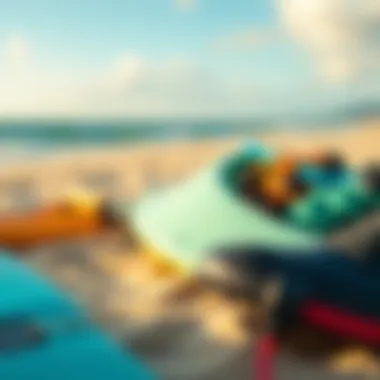
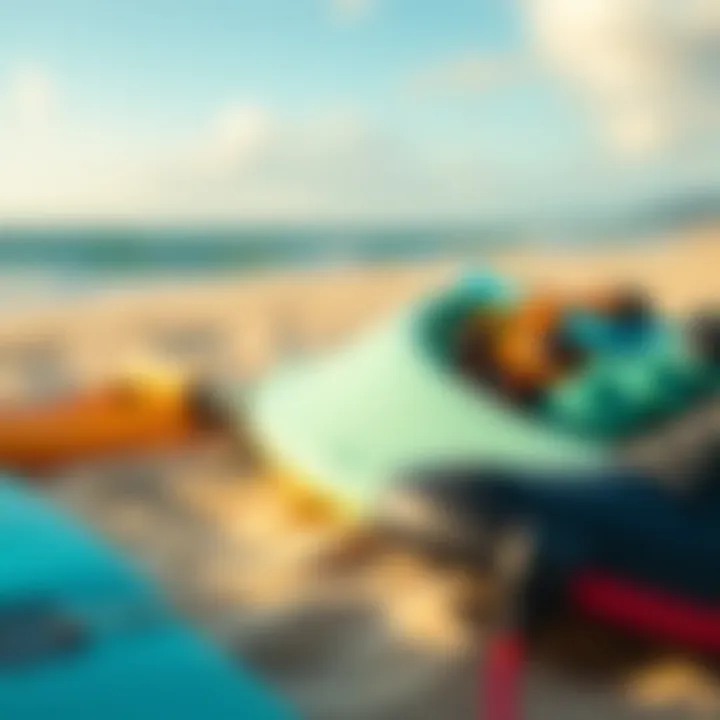
- Considerations for Board Selection:
- Riding style (freestyle, wave, or freeride)
- Desired flex and stiffness
- Weight and size for buoyancy
Comparative Reviews of Safety Gear
Safety gear is a non-negotiable aspect of kitesurfing that deserves meticulous examination. Helmets, life vests, and impact shorts have evolved significantly over time as well. It’s vital to have gear that not only fits well but is designed to absorb impact effectively without restricting movement. Brands like Mystic and Ion have set industry standards for quality.
When reviewing safety gear, one might want to compare features like:
- Impact Resistance: How well does the helmet absorb shock?
- Buoyancy: Is the life vest adequately buoyant without being cumbersome?
- Comfort Fit: Does the gear allow for a full range of motion while still providing support?
For a thorough understanding, consumer feedback and expert reviews can offer insights that manufacturer claims often don't. Engaging discussions on platforms like Reddit can further illuminate firsthand experiences, ensuring you choose what fits your needs best.
This meticulous approach to reviewing kitesurfing gear can lead to not just a safer but more enjoyable time on the water. Whether you are new to kitesurfing or a seasoned professional, keeping abreast of gear advancements is key to optimizing your experience in the beautiful waters of Honolulu.
Traveling to Honolulu for Kitesurfing
Traveling to Honolulu for kitesurfing offers more than just windy days, it opens doors to rich experiences and local culture. Those planning a trip need to keep a few key elements in mind. First off, the island's unique blend of wind patterns and scenic coastlines make it a haven for both novice and experienced kitesurfers alike. Shaping your trip around ideal conditions can significantly enhance your time spent on the water. More than just a space to fly a kite, it’s about connecting with fellow adventurers and soaking up the natural beauty that surrounds you.
Transportation to Popular Spots
Navigating Honolulu for the best kitesurfing spots requires some planning. Public transit can get you close, but having a personal vehicle often proves more convenient. Rental cars are widely available, and they allow easy access to varying locations like Kailua and Lanikai Beaches, where the scenery is second to none. Consider organizing your gear efficiently, as some spots may involve short walks from parking areas.
"The beach isn't just a place; it's a community. Understanding the lay of the land can make a good trip great!"
In addition to cars, rideshares, such as Uber and Lyft, operate in the area, offering flexible transportation options. If you’re traveling solo, these can be cost-effective and not too much of a hassle. On days when conditions are optimal, the beach can get busy. Arriving early can help you snag a good parking spot and give you some quiet time to prepare.
Accommodation Options Near Kitesurfing Locations
Finding the right place to stay can create or break your kitesurfing experience. Numerous accommodations exist near popular kitesurfing locations in Honolulu. Options range from beachfront hotels providing immediate access to the water to charming B&Bs nestled in the lush landscapes of Oahu.
- Hotels: Many resorts along Waikiki Beach offer amenities tailored for water sports enthusiasts. Places like the Moana Surfrider provide easy access to kitesurfing and a touch of luxury. You won't have to go far to find your kitesurfing buddies or grab that bedtime snack.
- Vacation Rentals: Look into platforms like Airbnb for local stays. Many hosts offer unique accommodations from cozy apartments to spacious homes, which are often more cost-effective for groups. These spots give you a chance to immerse yourself in Hawaiian life while still being close to the waves.
Things to consider when booking are:
- Distance to the nearest kitesurfing spots
- Local reviews mentioning the significance of location
- Amenities suited for gear storage and preparation
Staying a stone's throw away from the action means you can maximize time spent on the water and minimize unwelcome surprises. All that effort to get there deserves a comfortable place to rest after a day of riding the wind and waves.
Personal Experiences and Stories from the Kitesurfing Community
Understanding kitesurfing goes beyond just the gear and techniques; it's about the culmination of experiences that shape the community. Personal stories shared by kitesurfers highlight their journeys, challenges, and triumphs on the water. They provide not only inspiration but also invaluable lessons, making this section critical for both newcomers and seasoned riders. This blend of narratives weaves a rich tapestry, reflecting the culture and camaraderie inherent in kitesurfing. In this vibrant environment, we see how personal encounters can motivate, educate, and evolve the experiences of others.
Interviews with Local Kitesurfers
Diving deep into conversations with local kitesurfers can reveal a treasure trove of insights. These enthusiasts offer authentic glimpses into what it means to ride the waves in the stunning locales of Honolulu. Each interview offers a unique flavor, from tales about overcoming beginner’s nerves to the thrill of performing stunts after countless hours of practice. Local riders often share their favorite spots, ranging from hidden gems to popular beaches, explaining how each place has contributed to their kitesurfing journey. One common theme often surfaces: the supportive nature of the community, especially for those just starting out.
Imagine chatting with someone like Tyler, a lifelong resident who took to kitesurfing ten years ago. He narrates the challenge of battling his fears during his first ride and how he learned from local instructors. "I remember getting dragged through the water like a kite out of control. But the support I received from the crew around me? Priceless. That’s what kept me going," he says. These stories, whether they speak of initial struggles or breakthrough achievements, serve to bond individuals and enrich the community spirit.
User-Generated Content Submissions
In today’s digital age, sharing experiences has taken on various forms thanks to platforms such as social media and community forums. User-generated content allows kitesurfers from all walks of life to share photos, videos, and tales of their escapades. This content isn't just for bragging rights; it cultivates a sense of belonging. When someone showcases their latest trick captured on film or shares a blog post about a recent trip to Lanikai Beach, they invite others into their experiences. This exchange fosters learning and encourages others to share their narratives in return.
"Kitesurfing isn’t just a sport; it’s a way of life for us here. We share our rides online, and that inspires new kitesurfers to jump in!" - Aloha Kitesurfing Community
Such submissions can often be found on platforms like Reddit or Facebook groups dedicated to kitesurfing, where budding riders ask for tips or share their progress. The conversation ranges from gear recommendations to weather conditions, creating an interactive space for enthusiasts. In essence, this user-generated content plays a crucial role in maintaining the vitality of the kitesurfing community, making personal stories more accessible and relatable, ultimately enriching the kitesurfing culture in Honolulu.
Closure
In wrapping up this extensive look into kitesurfing in Honolulu, it becomes clear that this thrilling sport offers far more than just a rush of adrenaline. For enthusiasts—be they seasoned kiteboarders or curious travelers—kitesurfing opens up a world of adventure, connection, and environmental appreciation.
While we’ve explored various aspects throughout the article, the essence of kitesurfing hinges on a few key elements. Firstly, the unique geographical features of Honolulu invite thrill-seekers to experience unmatched conditions. The wind patterns and ocean currents create a playground that is not just fun, but also rewarding for those who take the time to learn and understand them. The islands' stunning coastlines serve as exceptional backdrops, enhancing every session on the water.
Moreover, the community aspect cannot be overstated. Kitesurfing in Hawaii is not just a solitary endeavor. It’s about sharing waves, skills, and stories with fellow kitesurfers. Engaging with local communities enriches the experience, offering insider knowledge and fostering friendships that often last beyond the beach. This reinforces the cultural significance of kitesurfing in Hawaii, allowing participants to appreciate and respect the deeper connections that the sport has within the islands.
As we emphasized in the earlier sections, safety continues to be a prominent theme. Understanding local regulations and potential hazards plays a crucial role in ensuring that all participants can enjoy their time on the water responsibly. The more informed kitesurfers are, the better the overall community’s experience will be.
Lastly, considering the future of kitesurfing in Honolulu, it’s evident that the sport is likely to continue thriving. Emerging trends and sustainable practices will help to protect the local ecosystems, ensuring that generations can enjoy the beauty of kitesurfing just as current enthusiasts do.
Future of Kitesurfing in Honolulu
The outlook for kitesurfing in Honolulu appears quite bright, intertwining technology and local culture in ways that promise to enrich the kitesurfing experience. This section delves into emerging trends and technologies that are shaping the future of the sport, as well as the potential for growth in the local kitesurfing communities. These topics are not just essential for enthusiasts but vital for sustaining the practice and integrating it into the fabric of Hawaiian life.
Emerging Trends and Technologies
As the sport embedded in the azure waters of Honolulu evolves, so do the technologies and methodologies that support kitesurfers. New kitesurfing gear is continually being designed with an emphasis on agility, stability, and ease of use. Modern kites are lighter, making them more responsive in various wind conditions. Boards are also becoming more innovative—many now incorporate lightweight materials that enhance buoyancy and turn capabilities.
Among the noteworthy trends is the increasing emphasis on sustainability. Being eco-conscious is growing in importance among kitesurfers, matched by similar strides across the globe. Newer kite designs are being made from sustainable fabrics and recyclable materials. This aspect not only reduces resource depletion but also imparts a sense of responsibility to those enjoying the waters.
Furthermore, technological advancements in apps are increasingly providing real-time data about wind patterns, weather conditions, and ocean currents. Platforms such as Windy (https://www.windy.com) and Sailflow (https://sailflow.com) stand out, offering comprehensive visuals that help kitesurfers make informed decisions about where and when to kite.
"The sport is not just about skill anymore; it's also about understanding your environment, thanks to tools now at our disposal."
Device wearables are also making waves in the scene. Devices that track performance metrics or even communicate with social media are gaining traction, allowing kitesurfers to document their escapades seamlessly.
Potential for Growth in Local Communities
Honolulu stands at a crossroads of tourism and community engagement that bodes well for kitesurfing. As local interest in the sport continues to surge, opportunities for growth and education within communities are expanding. Kitesurfing schools and lessons are proliferating, attracting newcomers who, in turn, become invested in the local culture.
Engagement with local businesses is crucial as well. For instance, partnerships between kitesurfing schools and local hotels can create packages, drawing in tourists while cultivating local employment opportunities. This cooperative approach not only makes kitesurfing more accessible to visitors but enriches the local economy too.
Moreover, initiatives to host local competitions can stimulate community bonding and showcase local talent. Competitions not only highlight the skills of kitesurfers but also draw attention to Honolulu’s kitesurfing spots, potentially boosting tourism.
The increasing focus on inclusivity in watersports can’t be overlooked. Programs aimed at underrepresented groups foster diversity within the sport, encouraging a more multi-faceted kitesurfing community.
In summary, the future of kitesurfing in Honolulu is vibrant, filled with opportunities for innovation and community growth. By embracing new technologies and fostering local interest, kitesurfing can grow into an even more integral part of life on the islands.
